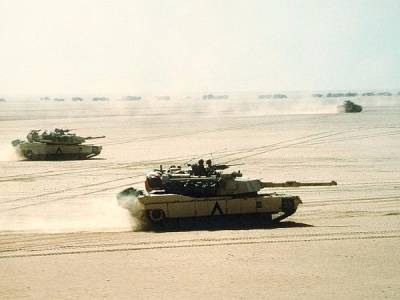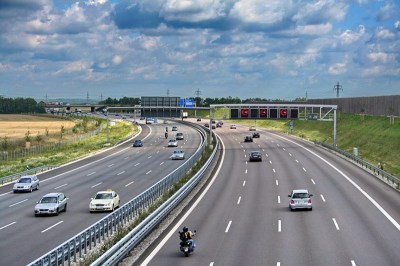When it comes to dominating offroad performance, many people’s first thought is of tracked vehicles. Bulldozers, tanks and excavators all use treads, and manage to get around in difficult terrain without breaking a sweat. Today, we’re exploring just what makes tracked vehicles so capable, as well as their weaknesses.
It’s All About Ground Pressure

Let’s first look at how tank tracks work. There are a huge variety of designs, with differences depending on application. Different trends have been followed over time, and designs for military use in combat differ from those used for low-speed construction machines, for example. But by looking at a basic tank track design, we can understand the basic theory. On tanks, the track or tread itself is usually made up of individual steel links that are connected together with hinges, though other machines may use rubber tracks instead. The tracks are wrapped around one or more drive wheels, often cogged, which directly pull on the track. On the bottom of the vehicle are the road wheels, which ride on top of the track where it lies on the ground. The weight of the vehicle is carried through the road wheels and passed on to the tread, spreading out the load across a broader area. Outside of this, the track system may also have one or more idler wheels used to keep the track taught, as well as return rollers to guide the track back around without touching the road wheels.

Tank tracks, or continuous tracks as they’re more technically known, were developed initially for farm and logging applications, for heavy vehicles that needed to operate in soft terrain. Continuous treads had the advantage that they could support a vehicle’s weight over a much greater area than wheels. Spreading out the load meant that the ground pressure was lower, and thus the vehicle was less likely to sink into soft mud or sand. It also allowed a vehicle to put much more torque to the ground without slipping, thanks to the much larger contact patch compared to regular wheels. The party piece of the tank — the ability to crush smaller road vehicles — is as much a result of its huge weight as its tracks. However, the tracks are less likely to get tangled or damaged when driving over another vehicle, compared to a pneumatic tyre.
Awful Highway Mileage

However, tracks come with drawbacks that make them unsuitable for many applications. There’s a reason you don’t see tanks taking people to work on the New Jersey Turnpike; if you did you’d probably assume something political had gone very, very wrong. For many vehicular applications, the simple pneumatic tyre and wheel combination is more suitable. Pneumatic tyres do less damage to paved surfaces than tracks, and are better suited to higher speed operation. They’re also less noisy, and far easier to replace when damaged. Tracks are significantly more mechanically complicated, with the average tank having many more wheels and moving parts, as well as the tracks themselves. All of these add some loss to the driveline, making tracked transport far less fuel efficient, too. Steering on tracked vehicles can also be complicated for single-engine setups, requiring special gear mechanisms to allow the speed of each tread to be varied appropriately. Additionally, while tracks are great on soft surfaces, they don’t offer anything particularly special when it comes to ground clearance. In many cases, a properly designed wheeled vehicle may out perform a tracked one in a rock-crawling scenario.
Tracks as a Drive Train

Tracks are also used on smaller scale vehicles, from robots to radio controlled toys. Here, they maintain the benefits of lower ground pressure compared to wheels. However, the often lower weight of smaller scale vehicles means this isn’t as much of a benefit as it is for a main battle tank that must carry up to 60 tons of armour and weaponry into battle. Smaller scale vehicles that run on electricity can have the benefit of running one motor per track however, eliminating much of the steering complexity in single-engine vehicles. Much like larger vehicles, while tracks may offer better performance in soft surfaces, ground clearance is still important for dealing with obstacles like rocks.
Overall, it’s important to remember that tracks were designed to do one thing well, and that’s get vehicles through soft, boggy terrain like mud, snow and sand. If you’re having to deal with such conditions, the tank track might be just the engineering solution you’ve been looking for. If, however, high speed, efficiency, or comfort are more important – you’re probably best sticking with wheels!















Both! Like Johny Five.
Legs! As many as needed to tread on sand.
Seriously though, wheels can also “turn on a coin”. A tread can be seen as a rail you deploy continuously for a hard wheel to roll on.
Funny that, how rails that trains run on are also known as tracks. ;-)
Tracks can turn in place also; run them in opposite directions. That does tend to chew up the surface they are on.
++ for legs. They have to operate in a legged-person environment, therefore they need legs. OK,. legs are hard. But stop taking the easy way out and do the thing. Boston robotics can do it. Asimo can do it (sometimes). Birds do it. Bees do it. etc. Lets all do legs.
Tracked vehicles kind of bring their own road, the tracks, with them .
For a perfect example of wheels done right for both ground clearance and the ability to handle virtually any terrain I would suggest watching some of the videos on YouTube showing the Sherp in action.
Wow, yeah, that’s incredible! It’s even a boat!
Im considering building my own steel tracked logging traktor (skidder). It Will have dozer blade on front (6 way blade), 4 steel tracks, articulated steering, winch, and on back anchoring shield. It Will be badass!
FMC made one, yes it was amazing to operate. Mechanical repairs were challenging. https://m.youtube.com/watch?v=ZsW7pRq38MQ
Check out the oddball railroad-wheel “truck” at the turn of the last century. Each wheel “lays” pieces of rail attached to the rim! That really had a speed limit by design.
Was it for building the track and it left the rail behind after itself, or it picked the rails up after it had travelled over them?
With new track and suspension technologies compared to 30 years ago tracks are gaining smoother ride quality and won’t damage the road as much(especially with rubber tracks that wear like a tire) but yeah it is funny watching videos of tanks tearing up roads when they try to turn
The tracks don’t have to move with the vehicle. They can be fixed to the ground. The vehicle drive wheels can engage the track using either friction or cogs. This is what is known as a railroad.
It’s sometimes hard to persuade people to put down tracks so that your cavalry can ride through them.
Yes, a really inflexible concept. It combines the disadvantages of land based travel regarding infrastructure needs with that of air travel which is also bound to schedules and “stations”.
You’re leaving out the advantages of trains here. Steel wheels on steel rails are much more efficient than rubber tyres on a road; fixed infrastructure means that the power source (electric power stations) can be upgraded independently of the vehicles (so the same train that used to be coal-powered might now be wind-powered).
Trains are limited on the slope they can climb.
Why do we have to choose?
http://tank-photographs.s3-website-eu-west-1.amazonaws.com/stridsvagn-strv-fm31-swedish-tank.html
Hehe, almost every sentence on that page is saying “This was a bad idea”. Imagine how bad it would have been if it had real armour, and a real gun, it would have popped those tyres in no time.
Oh I never said it was a good idea, actually it’s an awful idea, not only are the tires easy to deflate/destroy with weapons fire the added weight when not in use means less armour or weaponry. Still looks cool though!
Because bullets and sharp things generally make tires deflate, and those large tires look like easy to hit targets.
Tracks, because they are cooler.
“Additionally, while tracks are great on soft surfaces, they don’t offer anything particularly special when it comes to ground clearance.”
If you look at the diagram above, the drive wheels are situated much higher off the ground than the road wheels. The road wheels don’t have axles connecting them to their counterpart on the other side of the vehicle. So for the style of track in which the drive wheels are higher than the road wheels, your additional ground clearance is literally the difference in height between drive wheels and road wheels.
Secondly and more importantly, even with tracks where the drive wheels are inline with the road wheels – you do still have improved ground clearance – or rather ground clearance no longer matters: Picture a log laying across the road. You attempt to drive your pickup/suv over the log, and succeed in getting your front two wheels over the log, but ah crap, you now just high-centered your vehicle, turning it into a see-saw. This wouldn’t happen with tracks, assuming the tracks run the length of the vehicle. You effectively have increased ground clearance because the vehicle will always rise to the tallest part of an obstacle under any part of the track. With wheels you only experience this when the wheel is on top of the obstacle.
So I would definitely say tracks do give you additional ground clearance over a traditional 4 wheel arrangement!
I’m disappointed that no Hackaday reader has suggested Swedish wheels
A.k.a. Mecanum wheels.
Kind of consider them to be wheels. Pretty much only good for hard, level surfaces.
One important consideration skipped over is the short longevity and very high maintenance costs of the tacks on the bigger machines. I think they’re worn out after some 20.000km or so. That may be ok for a military vehicle or slow crawling dirt pushers, but would get very expensive for the daily commute. It would need 10 or more replacements over the lifetime of your car. Yuck!
Another important factor is the wobbliness of air tires. The air in the tire allows the bottom part of the tire to flatten for good road contact but this also means the whole vehicle is wobbly. This is not so handy for some robot with a robotic arm on top to grip and manipulate objects.
https://www.unusuallocomotion.com/pages/more-documentation-iii/110-special-off-road-vehicles-3.html
The real problem with heavier tank-tread robots shows up when you first drive on a surface with good traction — they require slip along the length of the tread to turn. On sand or snow, you’re slipping all the time anyway, so it’s probably fine.
But on pavement, you might find that your motors all of a sudden don’t have enough torque to slip the treads, and then you’re not turning.
Or like my tracked robot, which sheds the (rubber, drive wheels not toothed) tracks.
“Continuous treads had the advantage that they could support a vehicle’s weight over a much greater area than wheels.”
A good example of this is the ‘Bandvagn 206’ a tracked troop transport used by various nations, mostly in arctic conditions. The tracks are so large, relative to the weight of the vehicle, that it puts less pressure on the ground than a human wearing normal boots. This means it can actually drive across thinner ice than a person can walk on. (It’s also amphibious in case it does break through).
It always seems slightly counter-intuitive to me, even though I understand exactly why it works.
“Taut”